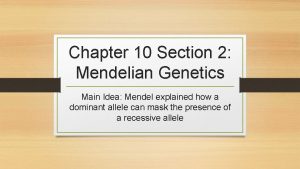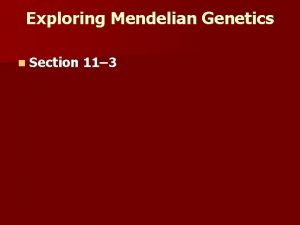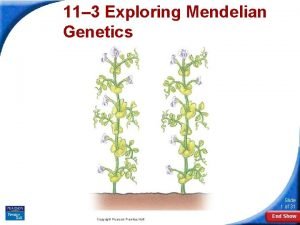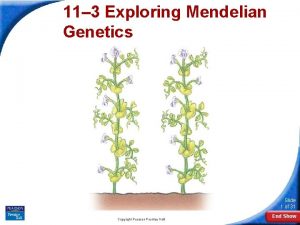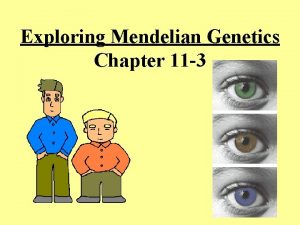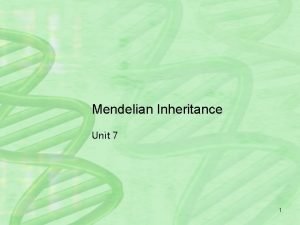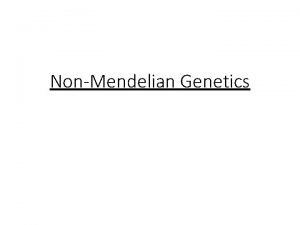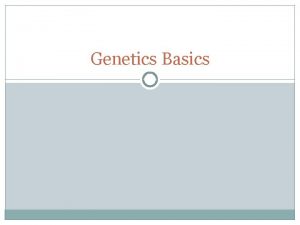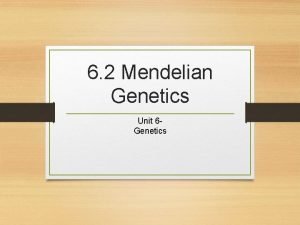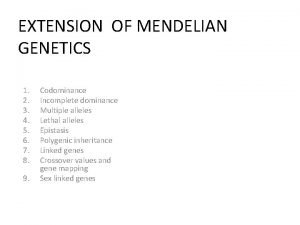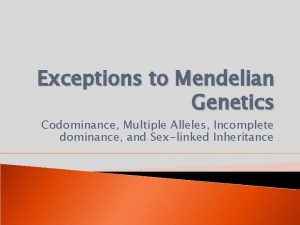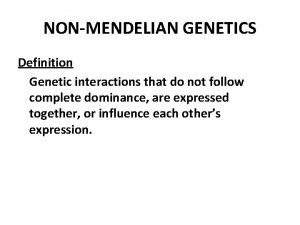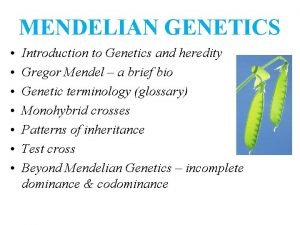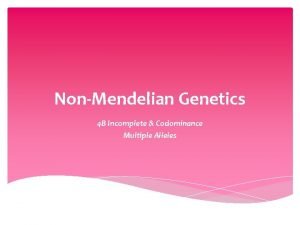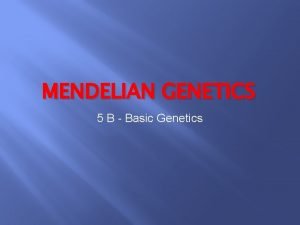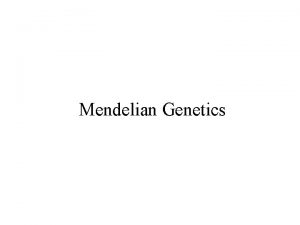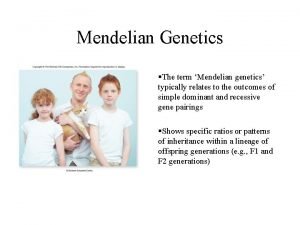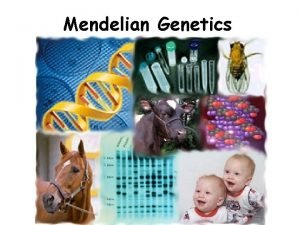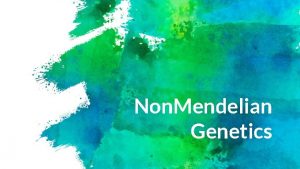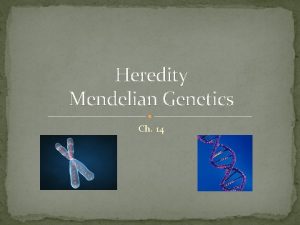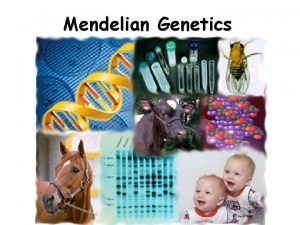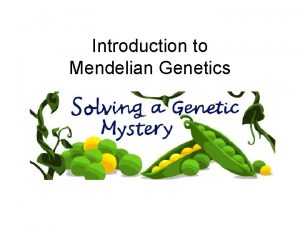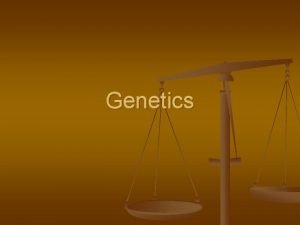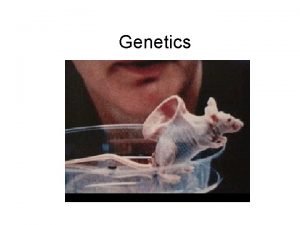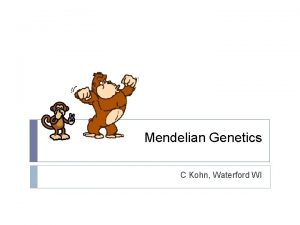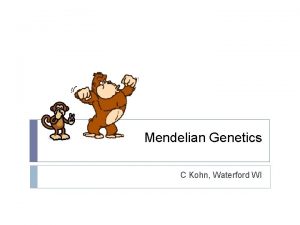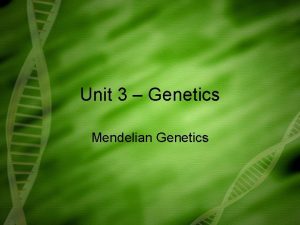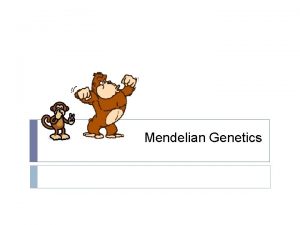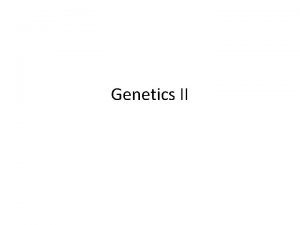Chapter 10 Section 2 Mendelian Genetics Main Idea
























- Slides: 24

Chapter 10 Section 2: Mendelian Genetics Main Idea: Mendel explained how a dominant allele can mask the presence of a recessive allele

Gregor Mendel: The Father of Modern Genetics • How Mendel Shaped the Field of Genetics • Austrian Monk with a passion for gardening • Began performing experiments on pea plants

How Genetics Began… • Heredity (inheritance) – passing of traits to the next generation • Genetics – the science of heredity • Mendel studied visible traits of pea plants, one at a time • Use math to recognize patterns


The Inheritance of Traits • Took plants that were truebreeding for one trait • Cross-pollinated them and expected a mixture of each trait in the offspring • Surprised at the results

The Results • After crossing plants true-breeding for flower color (P generation), all offspring were purple (F 1 generation) • Allowed F 1 to self-pollinate • F 2 generation had a mixture of purple and white in a 3: 1 ratio

Mendel’s Traits • Seed color • Seed shape • Seed pod color • Stem length • Flower color • Flower position Same 3: 1 ratio in F 2 generation with all traits


Mendel’s Conclusions • 2 factors that determine each trait • 1 from mother 1 from father • Alleles – alternative forms of traits • Gene = flower color; alleles = purple or white

Mendel’s Laws • Law of Dominance • Law of Segregation • Law of Independent Assortment

Law of Dominance • Certain traits are dominant to others • That trait will mask the recessive version • Recessive trait disappears in f 1 generation and reappears in f 2 generation • If the dominant allele is present, the dominant trait will be expressed

Law of Dominance • Dominant allele is represented with a capital letter (P); recessive allele with a lower case letter (p) • Homozygous – individual with 2 of the same allele for a trait (PP or pp) • Heterozygous – individual with 2 different alleles for a trait (Pp) • If the dominant allele is present, the dominant trait is expressed • The recessive allele is only expressed if 2 recessive alleles are present

Genotype vs. Phenotype • Genotype = genetic makeup; allele pairs • Phenotype = physical appearance; outward expression of allele pairs • PP = ? • Pp = ? • pp = ?

Law of Segregation • The two alleles for a trait segregate (separate) during sex cell formation • Alleles reunite in fertilization • So…each pea plant gets one allele from each parent



Law of Independent Assortment • Alleles located on different chromosomes assort independently of one another • In other words, pea color does not determine flower color, etc. • Assortment is random and each allele combination is equally likely to occur

Alleles and Genes

Punnett Squares T • A Punnett square is a tool used to predict all possible outcomes of a cross between two individuals focusing on a specific trait T t Tt Tt • The genotype of the mother is shown on the top of the square (TT) • The genotype of the father is shown on the side of the square (tt) • The various possible genotypes of the offspring are shown in the

Punnett Squares • What happens if you cross a heterozygous tall plant with a short plant? • Phenotypic Ratio = ? • Genotypic Ratio = ?

Punnett Squares • If deafness in dogs is recessive, show the possible offspring when 2 dogs heterozygous are mated. • Phenotypic ratio = ? • Genotypic ratio = ?

Test Cross • Farmer Dan breeds guinea pigs • There is a gene in guinea pigs for tooth length. Teeth can either be normal (T) or bucked (t) • Farmer Dan thinks he buys a homozygous normal (TT) guinea pig. How can he be sure that he has a “true-breeding” (TT) and not a heterozygous (Tt) guinea pig? • He performs a test cross – crossing an organism with an unknown genotype with one that is known

Test Cross • If it is TT, the result will be all normal teeth • If it is Tt, there will be a mixture of normal and bucked teeth T T t Tt Tt T t t Tt tt

PUNNETT SQUARE MADNESS!!!
 Chapter 10 section 2 mendelian genetics answer key
Chapter 10 section 2 mendelian genetics answer key Section 11-4 meiosis answer key
Section 11-4 meiosis answer key Section 11-3 exploring mendelian genetics
Section 11-3 exploring mendelian genetics Section 11-3 exploring mendelian genetics
Section 11-3 exploring mendelian genetics 11-3 exploring mendelian genetics
11-3 exploring mendelian genetics Section 11-3 exploring mendelian genetics
Section 11-3 exploring mendelian genetics Difference between mendelian and non mendelian inheritance
Difference between mendelian and non mendelian inheritance What is the implied main idea of the passage?
What is the implied main idea of the passage? Extending mendelian genetics
Extending mendelian genetics Section 1 chromosomes and phenotype study guide a
Section 1 chromosomes and phenotype study guide a Chapter 7 extending mendelian genetics
Chapter 7 extending mendelian genetics Mendelian genetics vocabulary
Mendelian genetics vocabulary Dominant
Dominant Heterozygous type a blood
Heterozygous type a blood Mendelian genetics punnett square
Mendelian genetics punnett square Holandric genes
Holandric genes Pprr x pprr punnett square
Pprr x pprr punnett square Horse xnxn
Horse xnxn Incomplete dominance meaning
Incomplete dominance meaning Codominance definition
Codominance definition Mendel experiments in plant hybridization
Mendel experiments in plant hybridization Pedigree miscarriage symbol
Pedigree miscarriage symbol Mendelian inheritance pattern
Mendelian inheritance pattern Mendelian genetics vocab
Mendelian genetics vocab Codominant allele
Codominant allele
